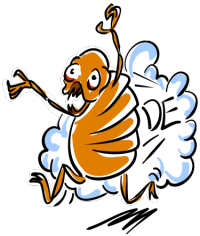I have heard two explanations of how diatomaceous earth works.

One is that on a microscopic level, the diatomaceous earth particles are very sharp looking. These particles stick to an insect and get stuck between its exoskeleton joints. As the insect moves, it gets physically cut up.
The other explanation is that diatomaceous earth sticks to the insect and somehow causes them to dry out. I think this approach involves scratching the insects waxy layer which then allows precious moisture within the insect to get out. So their teeny tiny bug-innards turn into teeny tiny bug-innards-jerky.
A reader, Sue, in Washington state writes:
Both are true and connected. DE is almost pure silica (with some beneficial trace minerals); under a microscope, it looks like shards of glass (glass is made from silica). On any beetle-type insect that has a carapace, like fleas and cockroaches, the DE works under the shell and punctures the body, which then dehydrates and the insect dies. DE is totally nontoxic. There is no buildup of tolerance like there is to poisons because the method of killing is PHYSICAL, not chemical.

The important thing to us is that if an insect with an exoskeleton gets diatomaceous earth on them, they die. At the same time, we can rub it all over our skin, rub it in our hair, eat it .... whatever ... and we are unharmed.
Diatomaceous earth kills all bugs. It has been reported to be the most effective solution when fighting pests like fleas, ants and bed bugs.
Farmers dump food grade diatomaceous earth by big scoops in with grains when the grains are stored. It kills the insects that want to feast on the grain. This is a great improvement over the stuff they used to put in with the grain.
Farmers feed gobs of diatomaceous earth (food grade) to animals in the hopes that it will cure whatever ails them. Many farmers swear that the stuff kills all sorts of worms in their critters.
Many people eat a quarter cup of food grade diatomaceous earth every day. They mix it into juice. I have visited with several people that are keen on living past 100 years that believe that eating lots diatomaceous earth every day will help them with that goal. I have found references where it is cited for colon cleansing, parasite control and detox.

One strange thing about diatomaceous earth is that for it to work on killing bugs, you have to keep it dry. Even morning dew can make diatomaceous earth ineffective.
I have encountered over a dozen ignorant boobs that have proclaimed "Diatomaceous Earth does NOT work!" I have read this statement in all caps. In extra big fonts. With italics. And I've even had it screamed at me. I'm gonna stick with "ignorant boobs". On closer inspection of each case there is always a flaw. Usually the problem is that it was not used correctly. Diatomaceous earth is not a bait. If you put a little bit in a pile somewhere, the bugs are not drawn to it and invite all their friends. I kinda wonder if the pesticide companies pay people to go to internet forums and say this sort of thing. Diatomaceous earth is super cheap, non toxic, and generally more effective than anything the pesticide companies have to offer - so it kinda cuts into their profit margins a bit. I've been meaning to create an experiment to set the record straight on this topic, but a participant in the diatomaceous earth discussion, Stephanie, beat me to it:
I tried my own experiment with the diatomaceous earth to see how quickly it kills the fleas; I caught a few fleas and put them in a jar with a pinch of diatomaceous earth - all were dead within just a couple of hours.
It just doesn't get any more clear than that.
































